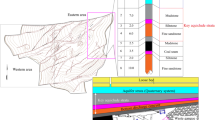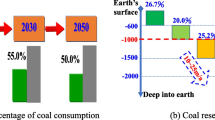Abstract
Determining the strata and surface movement of deep mining can provide a scientific basis for wellbore protection and mine land utilization. In this paper, numerical simulation methods were employed to investigate the stratum and surface movement boundary curves of deep caving and backfilling mining. The findings can be concluded in three aspects. First, the stratum and surface movement boundaries of deep caving and backfilling mining were all curved and conformed to an exponential function, but the influence range of strata and surface movement of deep different mining methods were different. Second, the backfilling rate of deep backfilling mining had an impact on movement boundary boundaries of strata and surface. With the backfilling rate decreasing, the influence range of strata and surface movement boundary were increased. Last, the research results were applied to a case to confirm the new approach of determining the influence range of strata and surface movement of deep mining. The example application shows that it not only can ensure the safe production of the wellbore, but also can enhance the reuse area of the mine field.









Similar content being viewed by others
References
Akulshin AA, Bredikhina NV, Akulshin An A, Aksenteva IY, Ermakova NP (2020) Development of filters with minimal hydraulic resistance for underground water intakes. Civ Eng J 6(5):919–927
Bian Z, Zhang Y (2006) Land use changes in Xuzhou coal mining area. Acta Geogr Sin 61(4):349–358
Fazelabdolabadi B, Golestan MH (2020) Towards Bayesian quantification of permeability in micro-scale porous structures–the database of micro networks. High Tech Innov J 1(4):148–160
Guo ZW (2017) The status and technical problems of deep mining in China. Coal 12:58–59
Guo JK, Wang SL (2014) Deformation analysis of lateral roof roadway based on internal strata displacement angle. Saf Coal Mines 45(10):204–206
Guo GL, Zhu XJ, Zha JF, Qiang WANG (2014) Subsidence prediction method based on equivalent mining height theory for solid backfilling mining. Trans Nonferrous Metals Soc China 24(10):3302–3308
Guo W, Wang H, Chen S (2016) Coal pillar safety and surface deformation characteristics of wide strip pillar mining in deep mine. Arab J Geosci 9(2):137
Guo G, Li H, Zha J (2019) An approach to protect cultivated land from subsidence and mitigate contamination from colliery gangue heaps. Process Saf Environ Prot 124:336–344
He GQ, Yang L, Ling GD (1991) Mining subsidence. China University of Mining and Technology Press, Xu Zhou
Jing Z, Wang J, Zhu Y, Feng Y (2018) Effects of land subsidence resulted from coal mining on soil nutrient distributions in a loess area of China. J Clean Prod 177:350–361
Kratzsch H (2012) Mining subsidence engineering. Springer Science & Business Media, Berlin
Lamich D, Marschalko M, Yilmaz I, Bednářová P, Niemiec D, Kubečka K, Mikulenka V (2016) Subsidence measurements in roads and implementation in land use plan optimisation in areas affected by deep coal mining. Environ Earth Sci 75(1):69
Lan H, Chen DK, Mao DJ (2016) Current status of deep mining and disaster prevention in China. Coal Sci Technol 44(1):39–46
Lechner AM, Baumgartl T, Matthew P, Glenn V (2016) The impact of underground longwall mining on prime agricultural land: a review and research agenda. Land Degrad Dev 27(6):1650–1663
Li H, Zha J, Zhang H, Zheng N, Guo G (2020) Design method for cadmium and arsenic contamination control during the mining-selecting-backfilling integrated technology. J Clean Prod 261:121259
Liu XJ, Cheng ZB (2019) Changes in subsidence-field surface movement in shallow-seam coal mining. J South Afr Inst Min Metall 119(2):201–206
Liu X, Wang Y, Yan S, Shao Y, Zhou H, Li Y (2019) Ground subsidence characteristics associated with urbanization in East China analyzed with a Sentinel-1A-based InSAR time series approach. Bull Eng Geol Env 78(6):4003–4015
Malinowska AA, Hejmanowski R (2016) The impact of deep underground coal mining on earth fissure occurrence. Acta Geodyn Geomater 13:4
Marschalko M, Yilmaz I, Kubečka K, Bouchal T, Bednárik M, Drusa M, Bendová M (2015) Utilization of ground subsidence caused by underground mining to produce a map of possible land-use areas for urban planning purposes. Arab J Geosci 8(1):579–588
Müller D, Preusse A (2018) Use of the area of main influence to fix a relevant boundary for mining damages in Germany. Int J Min Sci Technol 28(1):79–83
Nazarnia H, Nazarnia M, Sarmasti H, Wills WO (2020) A systematic review of civil and environmental infrastructures for coastal adaptation to sea level rise. Civ Eng J 6(7):1375–1399
Ranjith PG, Zhao J, Ju M, De Silva RV, Rathnaweera TD, Bandara AK (2017) Opportunities and challenges in deep mining: a brief review. Engineering 3(4):546–551
Wang GY (1994) Understanding of the subsidence basin boundary inside the strata. Mine Surv 1:35–36
Ye Q, Wang G, Jia Z, Zheng C, Wang W (2018) Similarity simulation of mining-crack-evolution characteristics of overburden strata in deep coal mining with large dip. J Petrol Sci Eng 165:477–487
Zhang J, Zhou N, Huang Y, Zhang Q (2011) Impact law of the bulk ratio of backfilling body to overlying strata movement in fully mechanized backfilling mining. J Min Sci 47(1):73–84
Zhang J, Zhang Q, Sun Q, Gao R, Germain D, Abro S (2015) Surface subsidence control theory and application to backfill coal mining technology. Environ Earth Sci 74(2):1439–1448
Zhou DW (2014) The synergy mechanism between rock mass and soil in mining subsidence and its prediction. Doctoral dissertation, China University of Mining and Technology.
Zhu X, Guo G, Zha J, Chen T, Fang Q, Yang X (2016) Surface dynamic subsidence prediction model of solid backfill mining. Environ Earth Sci 75(12):1–9
Acknowledgements
This work was funded by Fundamental Research Funds for the Central Universities (2019XKQYMS50).
Author information
Authors and Affiliations
Corresponding author
Additional information
Publisher's Note
Springer Nature remains neutral with regard to jurisdictional claims in published maps and institutional affiliations.
Rights and permissions
About this article
Cite this article
Li, H., Guo, K. & Guo, G. Strata and surface influence range of deep coal mining for mine land reuse. Environ Earth Sci 81, 68 (2022). https://doi.org/10.1007/s12665-022-10174-6
Received:
Accepted:
Published:
DOI: https://doi.org/10.1007/s12665-022-10174-6




